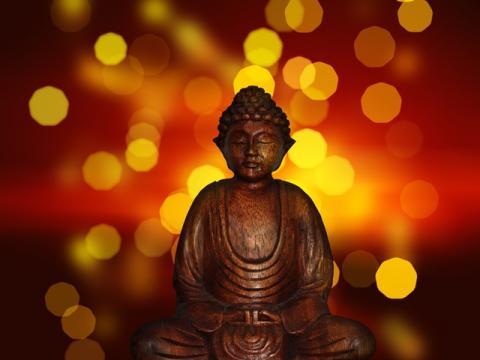
Often when meditation is mentioned people harbor some vague, albeit extraordinary, notion of hocus pocus incantation or yogis in India miraculously levitating a few inches off the ground by the sheer force of their consciousness.
While I cannot vouch for aberrations from the law of gravity, consistent meditation offers extraordinary benefits that might amount to practical magic in your life. The practice is helpful for anyone controlling errant thoughts that otherwise might swarm with chaos. Meditation clears clutter that might overwhelm a person in the alternative.
The discipline clears the mind so you can channel thoughts free of worry, towards life’s essence of goodness, and directly focus upon matters you care about. Also, meditation becomes an invaluable tool for your relaxation, optimism, and peace of mind.
A terrific form of meditation is chanting.
I chanted for 30 minutes at 4:00 a.m. when writing my autobiographical work on persona theory. I needed to conjure up the motivation and focus to sit for entire days plus many evenings with only my lonesome mind and my obedient computer. As a result, the inertia from my early morning chanting carried me over the disciplined span of sometimes 16-hour writing streaks for over a year!
I practice 13th-century Nichiren Daishonin Buddhism purely for the meditation benefits, but my practice excludes religious overtones. I chant the mantra “Nam Myoho Renge Kyo” in front of an altar called a Gohonzon. My Gohonzon is a Japanese scroll with symbols. It is inlaid in a rectangular box with two wooden doors. The mantra means meshing one’s recitation with the mystic law of the universe.
I simply repeat “Nam Myoho Renge Kyo” out loud, in rapid succession while thinking of each quality that I would like to transpose upon my character. I also envision goals that I would like to achieve or relationships that I would like to nurture. For each dozen or so repetitions of the mantra, I focus on ingraining a different modality of being.
The core belief of Buddhism is that we always have the capacity to surmount any difficulty that we may face. Nichiren Daishonin is the 13th century Buddhist monk who first taught the chant "Nam Myoho Renge Kyo" for all people to liberate the suffering from their lives via their inner resources. The mantra means devotion to the mystic law of the Lotus Sutra-- people's "inherent capacity for wisdom, courage, and compassion" (Sokai Gakkai International).
By chanting, we may transform any suffering into happiness. Chanting offers us the durability to eradicate suffering as our channeled energies become intertwined with the fundamental underpinnings of life. From our concocted impetus of repeating the mantra, we may achieve equilibrium with the universe. Consequently, we may achieve harmony with ourselves and our surroundings.
May aim is to say “Nam Myoho Renge Kyo” for 20 minutes in the morning plus another 20 minutes in the evening, for double the daily inundation. However, that is initially a tall order! It sometimes requires building up the duration slowly. Sometimes, I merely chant for only 10 minutes during each sitting, dependent upon my wherewithal and mood. Often, I drink a cup of coffee to appropriately perk up for the vibrant ordeal. Although the undertaking dramatically affirms one’s life force, it is necessary to summon enough energy to perpetuate.
The governing body of Nichiren Buddhists, Sokka Gakai International, has chapters throughout the United States and the world that hold meetings to encourage people to transform their lives through chanting. Leaders within the chapters are extremely enthusiastic about guiding newcomers to enhance their lives with the practice. I have had the pleasure of personally “shakabukuing” (indoctrinating) others to the discipline’s merits. Please do not ask me how the following came about, but my chanting chapter came to be known as “The Bodhisattva Beach Bunnies!” “Kosen rufu” is the aspiration for humanity’s collective well-being via chanting.
Because one assiduously, yet constantly, repeats only “Nam Myoho Renge Kyo” for 20 minutes or longer, it is a passive enough form of meditation that easily encourages active change to occur. (One is never at a loss of what to utter!). Intent focusing upon the mantra re-programs the algorithms in the mind’s thought process. As a result, we better free ourselves from worry and we are able to channel our focus more effortlessly and expediently. Thus, chanting is a form of meditation that makes people happier. (It is kind of like diluted laughing gas!).
Chanting also provides the inertia that inflates our sails to become whom we wish to be and go wherever we wish to go, beyond the horizon of our former fogginess and procrastination. Chanting offers impetus for seeking pleasanter pastures in the present and future, while releasing enough dopamine to bury the past because of the positive outpouring. The practice is kind of a vociferous expulsion from the guttural depths of the soul; an unabashed proclamation to the universe with intended follow-through, after the session terminates. Because the affirmations are entrenched within repetitively reciting the mantra, who would reasonably allow all of that percolating steam of our subsequent motivations to diffuse?! the mantras can be incredibly motivating. Therefore, chanting offers a kind of magical steamrolling that tends to accelerate our progress in the real world.
Sometimes it takes a while for the immense benefits of chanting to kick in. Initially, chanting can elicit nervousness before one hits pay dirt. It is normal for unsavory thoughts to boil to the surface in order to eventually get to the good stuff. And the practice must be consistently maintained every day to replenish the tremendous benefits. Nevertheless, the rewards of well-being outweigh any pitfalls or redundancy.
There is one minor caveat, though: If you decide to chant aloud on a park bench, you risk inadvertently occurring more than a bit kooky to passersby! Alone, amidst the foliage, I have sometimes been one of those bold benchwarmers— relatively unperturbed in my fortifying cocoon, if not altogether enlightening the clueless.







